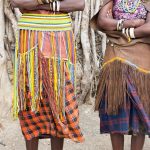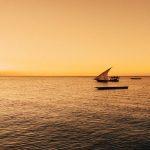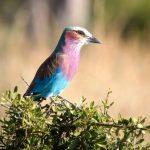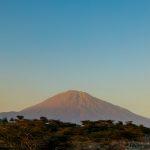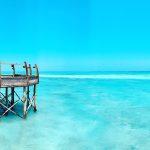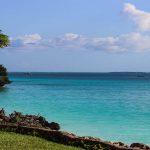Mafia is an archipelago of islands at the mouth of the Rufiji river delta, composed of Mafia Island, Jibondo, Juani and Chole. Their position as the most southerly islands on the Tanzanian coast has made them strategically covetable throughout the long game of historical wrangling for the rule, but visitors today find essentially rural farming and fishing communities whose day-to-day lives continue in much the same pattern as has been traditional for millennia.
Mafia Island and the surrounding archipelago have a great deal to offer as an unspoilt, little-visited alternative to other Indian Ocean locations around Zanzibar and along the coast, although options for accommodation and sea-faring navigation are all relatively expensive. Budget travellers will find it harder unless they are fully prepared with self-sufficient camping equipment. The archipelago provides excellent opportunities for diving and snorkelling, and for discovering deserted beaches and offshore islands fantastically imbued with rich/great natural and historic interest.
The deeper channels around the islands are also renowned for world-class deep sea fishing, and home to at least two greatly endangered species; the docile dugong (manatee or sea cow) is still thought to find refuge cruising the seagrass between Mafia and the Rufiji River Delta, and the small islands around the archipelago remain a popular breeding ground for giant and green turtles. These islands are an idyllic natural haven for birds and wildlife, with over 120 different species of birds sighted and recorded, (including five types of sunbird), and the whole area is best explored from the comfort of the deck of a traditional sailing dhow.
Mafia Island History
Debate continues as to whether the wide Rufiji Delta is the actual site for the lost metropolis of Rhapta, the trading town mentioned in the 1st-century guide to the Indian Ocean Trade Routes, The Periplus of the Erythaean Sea, and backed up by subsequent writings of the classical geographer, Ptolemy. Rhapta was said to be ‘beside and to the east of a cape with a river’, and about 30 miles from an island called Menouthias, described as ‘a low-lying island covered with trees in which there are rivers’.
Scholars believe that Menouthias may have been Pemba or Zanzibar, and yet there remains a possibility that it might have been situated around Mafia, with Kilwa as the port of Rhapta. But remains of this now legendary port and island have never been found, and if the old civilisation was once situated near the archipelago of Mafia Island it now lies well buried beneath the silting ebb and flow of the huge Rufiji River Delta. But there is history enough to be found on the islands today, with real stories and legends and an ever-increasing mass of evidence to verify their historic past.
Similar to Zanzibar, the first thousand years AD of Mafia history remain mysterious, although it is likely that the islands were settled by iron-working Bantu farmers from the mainland. Towards the end of the first millennium, these were joined by the first settlers who set sail on the north-east monsoon winds from the Arabian Gulf, and they are thought to have called the islands ‘Morfieyeh’, an Arabic word meaning group, or archipelago.
Legends tell how Mafia was settled by one of the sons of Ali bin al-Hasan the Sultan of Kilwa, who bought his territory from the ruling chief for a length of cloth in around 975AD. His son Bashat was posted up to Mafia to govern the wider realms of the sultanate, and perhaps he was responsible for establishing the earliest civilisations here, such as the stone towns of Ras Kisimani on Mafia Island, or Kua on Juani Island.
The early Arab settlers were especially attracted by the safety of the islands, Zanzibar, Pemba, Mafia and Kilwa. These were large enough to be self-supporting, far enough away from the mainland to exceed the possibilities of the local dug-out canoes and thus safe enough to contain slaves, wives and concubines who had no hope of swimming home. These were also easier to convert to the faith of Islam, and while the entire African continent was too great to hope to persuade, the few islanders were satisfactorily impressed and cowed by the grand new mosques erected in their midst.
The settlers continued to return to the mainland to trade, and brought with them a good deal of exotica, including glassware and pottery from Persia, porcelain and painted plates from Tang dynasty China, and ornaments and phials and brass lamps from across the Arabian Gulf. For all of these, they exchanged gold, ivory and slaves, and also leopard skins, rhinoceros horn, and highly prized ambergris, excreted from the stomachs of the many sperm whales that then cruised the Indian Ocean, and desired for its aphrodisiac properties and for ‘fixing’ perfumes and scents.
Many of these ancient possessions stayed buried beneath the ruins of the old Arab settlements, and locals around the Mafia Archipelago have discovered gold inlaid china, pottery and coins from as early as the 9th century in their fields, although the majority of shards date from the later 12th to 14th centuries, when the settlement at Mafia was at its height.
But such a rise in fortunes was doomed to fall. Vasco da Gama historically sailed his Portuguese fleet around the Cape of Good Hope, rounded Mozambique and on April 4 1498, sighted Mafia to starboard on his northbound course. But it wasn’t until 1505 that the first Viceroy returned to the islands to depose Arab rule, and marked his maps with the islands of ‘Monfiyah’, misinterpreting the Arabic ‘Morfiyah’.
During the 16th and 17th centuries, Mafia was subjected to the joust for power between the Omani and Portuguese, until Oman trounced them in Mombassa in 1698 and the Sultan of Oman took outright control of the coast, from Lamu to Kilwa. But despite their constant pestering for taxation and payments, the Portuguese did not bring about the fate of the Mafia civilisations as much as the people themselves.
The settlements of Kisimani and Kua developed an unfortunate enmity between them that was their final downfall. It is said that it began when the people of Kisimani, who were called the WaDibri but were also Sacklava people from Madagascar, invited the townsfolk of Kua to join them in the celebration of the launch of a huge new ship that they had built. The people of Kua arrived and gathered around the boat, when suddenly the Kisimani locals snatched some of their children and laid them on the sand, then launched the ship over their bodies.
Townspeople of Kua returned distressed and found no time better to wreak their revenge than seven or eight years later at the wedding of the king’s daughter. This time, they invited the people of Kisimani to celebrate, and as the guests arrived they were ushered into a specially prepared underground room. Gradually all but one of the hosts slipped away, leaving just one old man entertaining. And so well did he do so that no one noticed as the door was bricked up…and it is said that their bodies remain there to this very day.
So the story continues that it was as a result of these foul deeds the town of Kisimani was sunk beneath the waves, and many years later the people of Kua suffered further vengeance from an army of Sacklava cannibals from Madagascar, who returned in a fleet of 80 canoes in 1829 to sack the town. Those who did not escape were killed, eaten or kept as slaves. The Sultan of Zanzibar heard of the destruction of this then-major settlement and sent a regiment of his personal Baluchi troops to the island to restore order, but although they captured the offending pirates and brought them back to Mafia as slaves, the town of Kua was never rebuilt. Instead, Sultan Said established a new settlement on Chole Island, which had previously been home to slaves alone, and there are those living around Kitoni near Kisimani on the west coast said to be descendants of his original Pakistani regiment.
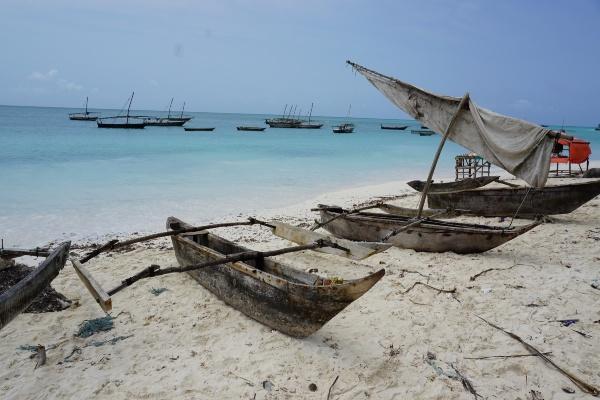
Mafia Island today
Today, each of the four main islands are inhabited by farming and fishing villages and homesteads, where smallholder farmers grow a variety of crops including rice, cassava, pineapple, paw paw and beans, and most households tend to have cashew, coconut and mango trees. This area of the coast is richly surrounded by various coral reefs and marine life, and diving in these waters is rewarding for divers of all abilities.
The high diversity of reefs and extensive work to document and preserve them by organisations such as Frontier and the WWF brought about a much-needed government protection order, and after many years in the making, the creation of the Mafia Island Marine Park – Tanzania’s first marine park.
What to See on Mafia Island
The town of Kilindoni provides a colourful introduction to Mafia today, and although the Germans made it their centre for administration and harbour in 1913 there is little sign of their inhabitancy today. The town is essentially a small, bustling fish, fruit and vegetable market, with a gently enjoyable Swahili colour. Anyone requiring supplies should certainly try and find them here. The bank and post office are both on the airport road, with the bank open between 8.30 am and 3 pm Monday to Friday and until 12.30 pm on Saturdays. Items such as fishing lines, hooks and sinkers can be found in the market, as can all kinds of food supplies, kangas, etc. A local café behind the market serves simple dishes of fish, rice and ugali, and sodas available from the Peace and Love shop and the Market General Supply Store.
About half an hour’s drive south of Kilindoni brings you to Kisimani on the south-westerly peninsula. This is the site of probably the earliest settlement on Mafia, which was flourishing by the mid-11th to 14th centuries, during which time there was a great palace here. It is said that after the completion of the palace orders were given for the amputation of the hands of the chief builder, a slave so that he could never recreate his work elsewhere. There is no longer very much to see here, although the journey may be worthwhile to find wide and beautiful palm-fringed beaches. Kisimani means ‘Place of the Well’ in Swahili, and part of the original old well can still be made out on the beach. But while these ruins have suffered the greatest demise at the peril of the seas which continue to crumble their cliffside foundations, many of the early pot pieces and coins have been found here, exposed by the action of the waves.
There is a tiny island just west of Ras Kisimani called Bwejuu, a small coral outcrop surrounded by sandy beaches.
Wildlife on Mafia Island
The islands are inhabited by a great diversity of wildlife, with hippos residing in a pool at the centre of the island and sykes and vervet monkeys, galagos bushbabies, blue duiker, genet cats and wild pigs in the forests and bush. There are also plenty of Pteropus Giant Fruit Bats, a colony of which can be seen roosting on Chole Island.
Mafia Island provides an excellently relaxed and unspoilt spot for birdwatching, with over 120 species recorded on the lists assiduously kept by Kinasi Lodge. Some of the best areas for birdwatching are the woodlands and forests that run along the Kua Channel, and the northern reaches of Mafia Island. A wide variety of bird species can also be spotted from the comfort of the balconies and gardens of the hotels around Chole Bay, and on the offshore islands.

Diving on Mafia Island
The numerous reefs that make up the Mafia Island Marine Park provide a range of possibilities for excellent diving to suit all abilities. The archipelago has richly varied and sheltered reefs in the Chole Bay that provide good opportunities for learners and beginners, with more advanced diving and drift diving through Kinasi Pass, where the current is stronger, and then more advanced possibilities in the outer channels.
Most of the best diving here is at depths less than 30m, within which there is a stunning diversity of marine life, including over 50 genera of corals and 400 species of fish identified so far. Local dives around Chole Bay reveal excellent examples of giant table corals and huge blue-tipped staghorn corals, and the coral outcrops or ‘bommies’, behind the Kinasi and Chole walls, provide superbly colourful photo opportunities and fine snorkelling at low tide.
Kinasi Lodge arranges all forms of adventure dives, including night dives, wall dives, reef and drift dives, the last of which carries through Kinasi Pass and often leads through shoals of Barracuda. On a spring tide, the current can be very strong and fast, allowing for only 20 to 35 minutes to cover a distance of a couple of kilometres. These drifts don’t have to be deep, but divers should be experienced, and those with less experience should time their dive for a more gentle current. The Kinasi Wall and Chole Wall are also popular, varying in depth between 8 and 21 metres. These have an excellent variety of corals, with shoaling and reef fish and turtles commonly sighted, and are always full of interest.
The Pinnacle is a 12m spire of coral rock close to the rock island in the Kinasi Pass and provides an unusual dive site in the channel for its mixture of pelagic and reef fish. Old regulars often encountered here are a very large moray eel in his rock home on the western side of the stack, and an equally sizeable potato cod, named Charlie.
Outside the bay, there are fine deep dives at Dindini North Wall and Forbes Bay, where larger fish such as shark, tuna and mid-sized groupers and shoals of red-toothed triggerfish are found, and there is a chance to encounter uncommon species of butterflyfish, including Meyers, Black Pyramid and the Longnose. The boat ride to these sites is exciting enough in itself and provides seasonal opportunities to trawl for gamefish on the way. Kinasi Lodge can arrange excursion dives for a full day trip or overnight camping, and they keep ‘The Guide to Diving Mafia Island: An Unexplored Paradise’, put together by FRONTIER during their years of research here, in their reference library.
The Mafia Archipelago has opportunities for some of the finest and most diverse diving and snorkelling along this coastline, with the absolute best conditions between December and March. Anyone keen to take specialist adventure dives or beginners courses are advised to book their requirements in advance, and thus ensure that the tide, moon and instructor are all prepared for your arrival!
Fishing on Mafia Island
The waters around Mafia are famed for their fishing potential, with world records for big game fish caught here, with the main season running from August to March. For those interested in partaking in the size-driven sport the best season is between July and November, as this is when the northeast monsoon brings in the greatest variety of fish, with, kingfish, barracuda and tuna among the favourite big catches. A 57kg yellowfin tuna holds at least one record, and rather wonderfully a 34.2kg dorado caught here in 1950 by mystery spinner Sir Arthur Conan Doyle still holds the record for all of Africa.
The best fishing for billfish, sailfish and marlin, is between December and March. Fly-fishing in the saltwater creeks and light and heavy tackle fishing in the reef and channels is good at any time of year, and all fishermen who do successfully fight a big fish on their line can be assured of great popularity with other guests when they supply supper. Kinasi Lodge is a member of the International Game Fishing Association and provides weighing facilities and rods and tackle, although serious fishermen might prefer to bring their own. Kinasi also holds a Mafia Channel Fishing Tournament each New Year.
The overgrown ruins of the German administration on Chole provide an eerie sense of the imposing power of colonialist rule. These old stone edifices stand in grand alignment along a wide and immaculately straight central pathway, although the old stone gaol and boma are now freely open to all the whims of nature. There are also fewer distinct remains of the older Arab settlements here.
The island is also home to a sizeable roost of giant fruit bats, sign-posted along a path past a chirruping Qu’ran school, although the noisome racket of the roost at morning and night is guide enough. The docking beach at Chole is a good spot to see traditional boat-building and sail-making, in which all materials are impressively fashioned by hand.
This tiny island, only 1sq km, is a peaceful and natural haven to wander at leisure. The local people are friendly, and it is interesting to see their smart mud and pole houses, often well-decorated with pebbles to add colour and style. The pathways around the island sometimes take a fine line through the garden plots, growing mainly cassava and beans, and the newly extended school and clinic are encouraging for further achievements here.
Boats to Chole should be easily arranged with your hotel, although it is very easy to jump aboard the popular local dhow ferry from the beach at Utende, just in front of the Mafia Island Beach Hotel. This ferries back and forth regularly throughout the day until 4 pm, and the beachside wait is pleasant as the boat is always in view. The fare is about Tsh200, and the ferryman and crew are welcoming and friendly, as long as you are decently dressed!
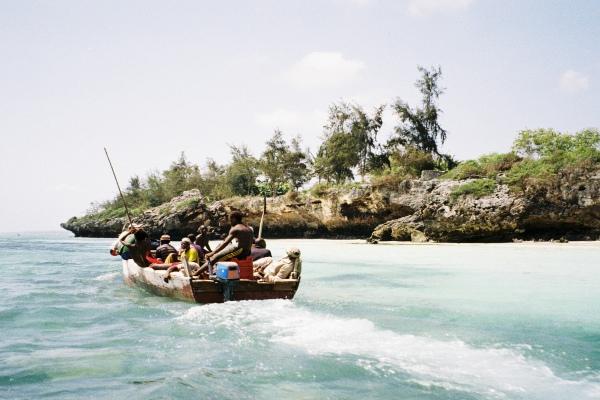
Chole Island to Juani Island
The remains of the legendary civilisation at Kua are on the west coast of Juani Island, approximately a twenty-minute boat ride from Mafia Island and only accessible at high tide. The ruins cover a huge distance and are generally overgrown although enough stands to give some impressive account of the fine civilisation that once existed here, although the earliest structures are not much in evidence. The ruined mosques date from the 14th century, while other surviving ruins are generally much later, from the 18th century. The largest standing ruin is a vast double-storey structure with stone stairs and a maze of anterooms, although the state of the ruins makes it hard to get around. Coral stone steps run up to the second level, from where a flue runs from the bathroom to a pit beyond the outer wall, and beneath the stairs, a small chamber room is said to have confined badly behaved slaves.
The ruins still sustain a strange aura of bygone grandeur, and local people have deemed areas spiritual enough for offerings to be left here. An extremely old but remarkably lithe caretaker lives in a small hut just beyond the ruins, and although he is unlikely to offer much assistance he is grateful for contributions – you do have to squelch through his cassava plantations to walk between the ruins, and the house in front of his hut is said to be the very place where the townspeople of Kisimani met their untimely fate…
Nearby, surrounded by cavernous stone tombs, the ancient central mosque still stands, albeit without its roof, which crumbled recently, but complete with vast internal pillars and sculpted mirhab. Potsherds and beads can be found in the earth all around the area, and glint amongst the shingle on the beach.
The island of Juani also had a reputation for its medicinal powers, as the milk from the island was said to have curative properties and the seawater pool that fills one of its caves was widely believed to cure aching joints, such as rheumatism. The effectiveness of this natural saline bath is however dependent upon the quality of sweet and delicious offerings brought by the afflicted for the Mohammedan custodian of the cave, who continues to hold a legacy of partiality to honey and dates.
Island explorers might like to range through the undergrowth to find the ‘Green Lagoon’ of the Kua channel, which provides an unusually shady swimming hole and a huge and apparently friendly grouper bids you welcome. The Lagoon is most easily accessible from a boat, about halfway along the Kua Channel.
History of Chole Island
It may be interesting to note that Chole was also the name of one of the numerous daughters of Sultan Sayyid Said, greatly favoured by her father and described by her sister Salme, ‘There was, indeed, no one to equal her in our whole house, as there was, indeed, no one to equal her in our whole family, and the fame of her beauty spread far and wide.’ It may have been at this time that the island got its name, or she hers.
The Omani Arabs developed an unusually orderly settlement at Chole, which appealed greatly to the German occupants when they were awarded Mafia under the treaty of 1890, and swapped with the British for territory between Lake Nyasa and Tanganyika. Germany paid Sultan Syyed Ali ben Saad of Oman DM 4 million for Mafia and part of the mainland coast, and the German flag was raised over the island. The first German resident arrived in 1892 with a number of Sudanese troops and began construction of what later developed into a grand ensemble of buildings on Chole Island. The original double-storey boma and a thick-walled gaol can both still be seen, although now twined with roots and rubble. But the colonial town at Chole became less important around 1913 when the administrative capital was moved to its present site at Kilindoni on the Mafia channel, and the route of the coastal steamship service.
In January 1915, British troops took Mafia as a strategic base for the air and sea assault on the German cruiser Konigsberg, which had hidden in the Rufiji River Delta for repairs. The British searched all night and day to find the ship, and then finally it was spotted from an aeroplane and put out of further action, although the Germans salvaged the guns. The British continued to rule under martial law until late 1922 when Mafia finally became the territory of Tanganyika.
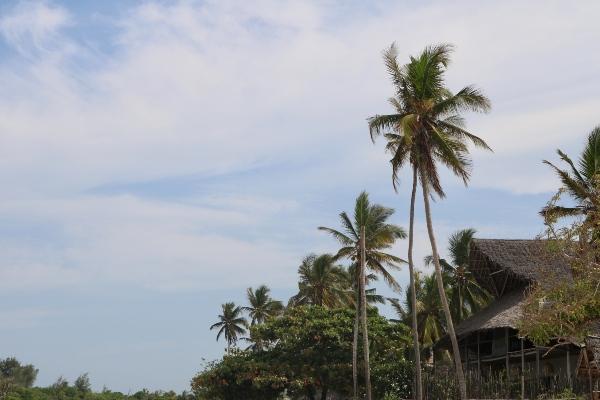
Chole Island to Jibondo Island
Around 20 minutes sailing from Juani, Jibondo Island has a sizeable community, with a reputation for its prowess as boat-builders and fishermen. All their building methods are entirely reliant on simple hand tools, with even hand-made nails to keep the vessels together. The women of Jibondo are said to be unusually adept at sailing and fishing, and the community is unusually organised into immaculate grid-like streets at one end of the island, with all fields for cultivation at the other.
It is also possible to arrange dhow trips to other areas around Mafia Island and the smaller islands of the archipelago, to find small, often deserted beaches and rural fishing communities. Bweni, on the northernmost tip of Mafia Island, is stunningly beautiful, peaceful and unspoilt, and Dinidini Beach on the Eastern peninsula above Chole Bay is worth visiting, although it is only accessible at high tide.
There is a large coral rock pool behind the beach, surrounded by small dunes. It is often visited for a lunch stop after a diving expedition to the Dinidini Wall. Dimidizi Beach, to the south of Chole Bay, is also a fine beachside spot, about 4km from Kinasi Lodge. Offshore islands such as Baracuni, 12km northwest of Mafia, and Nororo Island, 12km north of Mafia, are quiet and natural hideaways used by fishermen. Nororo has a residential community and a couple of local restaurants for fish and rice dishes. You should be well-prepared for all excursions, with enough fresh water and refreshments, especially if camping. Kinasi Lodge can arrange camping trips to heavenly deserted beaches on the northern peninsula and Okuza and Nyuni islands (south of Mafia), complete with fly-tents, mattresses and lavish cool-box supplies.

